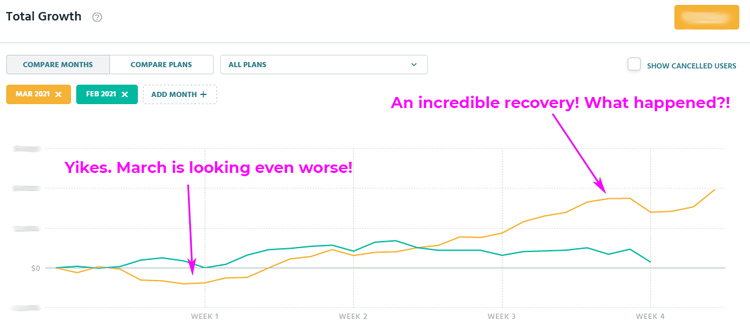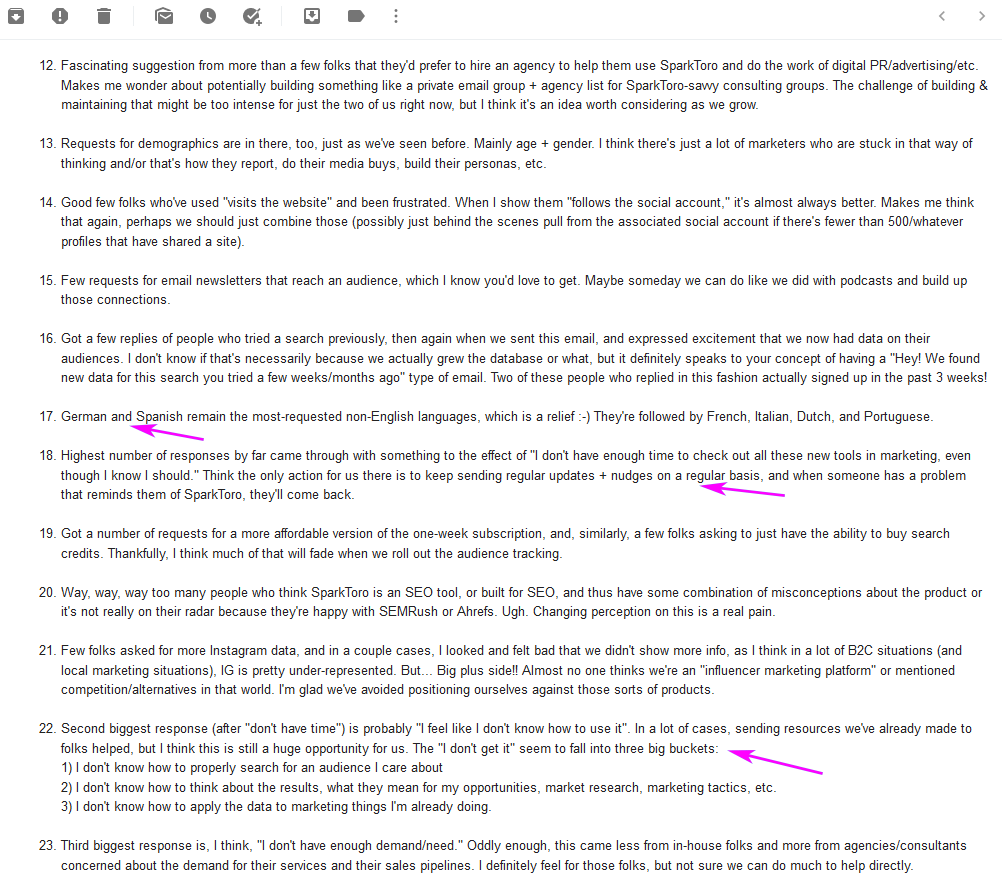Building a new company means constantly managing one’s emotions. The high highs of days when everything’s golden inevitably give way to the low lows when you’re certain it’s all doomed. At the end of February, Casey (my cofounder) and I were in that latter boat, nervous about how signups for our 10-month old startup had slowed to a trickle. Here’s a peek inside our Profitwell account so you can see for yourself:

Churn has been relatively consistent for us, and so had new signups, until the second week of February, when signups seemingly plateaued, then fell off a cliff. That decline continued for the first two weeks of March, so we did what any smart founder would: a whole mess of detective work. Here was our process:
- Examine quantity and sources of web traffic to see if we could identify a shift (results: nothing substantial)
- Examine conversion rates to the free account and from free→paid (results: free→paid was lower than usual, but only for older, pre-existing free accounts)
- Dig into a comparison of historical vs. current analytics trends to spot differences (results: returning visits from non-customers were lower than usual)
- Formulate hypotheses about what could be causing this, then try to validate them
That validation process started with an unusual idea, but one I suspect a lot of small businesses and startups can benefit from: directly asking our users, not with a survey, but with a personal email, including my address as the reply-to. Here’s what it looked like:

The email asked two questions:
- How much value do you get from your SparkToro account? And what are you using it for?
- What, if anything, holds you back from using SparkToro more, upgrading your account, and/or trying more searches?
It then encouraged recipients to reply with “even a two-word answer.”
The result? 719 replies (and counting), and a somewhat shocking change in SparkToro’s growth trajectory (even before we had a chance to reply or implement any changes). Here’s a look at March’s numbers:

Even as we were testing the email’s subject lines in small batches of a few hundred, we could see results. It appeared that simply reminding free users of the product that SparkToro existed nudged them to visit, try some more searches, and (at least for a few of them), upgrade to a paid subscription. Overall site traffic experienced a slight rise, but more than this, the conversion rate of older, less active, free accounts rose dramatically. At the end of March, we were more than 150% above our budgeted growth rate. As I type this, the growth rate for the first week of April looks similarly strong.
Takeaway #1: Remind Your Audience You Exist
For years, both Casey and I have been deeply hesitant to message folks who’ve given us their emails. Sure, they technically signed up specifically to receive product updates, to use the product, and to keep in touch, but… unless I have something truly newsworthy to share, I *feel* wrong contacting the ~31,000 folks on SparkToro’s list.
After this experiment, that bias is hard to maintain. Our Mailchimp delivery, open, and click-through rates are way above the averages for our industry (SparkToro opens on this email were ~37% vs. the software industry avg of 21.29%), and our unsubscribes are quite low. Not only that, but the data shows that messaging our subscribers at least every month or two results in a great deal more of them using the product, and is overall responsible for close to half our paid signups.
In my head, there’s still that little voice saying, “Don’t pester people! If they want your product, they’ll come to you.” But friends, that’s not how marketing works.

For the foreseeable future, Casey and I will make sure to have meaningful, useful messages to share, at least every month or two, with our email subscribers. I’m shifting my mentality from, “don’t pester people!” to “don’t ignore people who said they want to hear from you!“
Takeaway #2: Uncover Points of Friction, Solve Them, Then Tell People You’ve Solved ‘Em
While the first takeaway was somewhat surprising, the second one is not. We emailed folks asking for their feedback, and got a metric ton of it. The bad news is that for two unusually-heavy work weeks, I did almost nothing but reply to emails. That obviously put a dent in my productivity and personal life. The good news is that those 720 replies (I got another while writing this post and want to keep the count accurate), almost all fell into just a few major, definable groups.
Here’s the process we used, and one I’d recommend replicating:
- Emailed asking for feedback
- Took all the open-ended responses and put them in a spreadsheet
- Went through the first 150 or so and created “categories” (i.e. shorthand names for similar bits of feedback)
- Went through the full list and roughly classified the rest
- Distilled and summarized the feedback into problems we could address
- As a team, discussed the actionable ones, their level of priority, and how we could address them
- Rolled out a handful of short term changes (including some in-product nudges and upgrades)
- And, finally, emailed everyone on the list again with an update about the experiment’s results
I won’t share the full spreadsheet with everyone’s feedback (as I didn’t ask permission), but you can see a sample of the un-prioritized summary I sent to Casey in the middle of the process below:
These elements of friction in product use do suffer one big problem: they don’t all come from SparkToro’s “perfect customer.” Some of them certainly do, but many are likely from folks for whom our tool is a nice-to-have, not a must-have. When you’re in the early stages of startup product building, especially in self-service B2B, biasing to not-right target customers can take you badly off track.
To compensate, I did my best to identify respondents that looked (at least over email) similar to the kinds of folks who’ve been subscribing to and benefiting from our product. That’s slightly complicated by the vast array of customer types we’ve had (so wide that’s we’ve started to think SparkToro might be less of an “solves X for people in job role Y” type of company and more an “solves X for people who have problem Y” type), but still subjectively addressable.
The results were:
A) The short term product and funnel changes
B) The longer term list of prioritized tasks, product updates, and product marketing resources for Casey and I to build
C) The email below (sent to everyone on the list, again with my email as the reply-to)
This email did nearly as well in terms of open and click-through rate, but the replies were far fewer and more manageable (~120 in total). Despite knowing it was the right thing to do, I still worried that we were sending too many emails (2 messages in 3 weeks). That concern was quickly eliminated by the continually low unsubscribe rate, and the incredible kindness of the replies:

Email reply from Craig Gilhooly of Discoverable
I asked both of these folks for permission to reprint their emails here, but honestly, there were at least another 70 or 80 of those 120 that were equally sweet.

Email reply from Sonya Carmichael Jones (reprinted with permission)
It’s difficult to say with certainty whether the last four weeks of particularly strong signups is purely a result of reminding folks that we exist, or if the product changes (most notably search suggestions, and “how to apply results” on the Overview page), are the catalysts for this impact. But beyond even the signups, Casey and I were truly shcoked and excited by another, unexpected side effect: a dramatic rise in subscription recidivism. In the last 20 days, ~10 folks who’d previously cancelled their SparkToro subscription signed back up again. We’d had ~15 of these re-subscribers since launch, but have now nearly doubled that number.
My hope is that by sharing this story, I can help encourage your organization (and, if you’re a consultant, those you help) to consider replicating this process. Sending an email from your company’s founder/CEO to everyone who’s tried or considered your product and inviting a direct, personal reply, is a powerful, underutilized tactic. For some, it might just remind them you exist, and can solve their problem. For others, it’s a way to invite invaluable, open-ended feedback beyond what a traditional survey or interview process could provide. And when you quickly follow up with a “here’s what you told us and what we’re doing,” the responses in both tone and action might be astonishingly positive.
I hope you have as much (or more) success implementing it as we did, and if you’ve got questions about the process or want more details, please ask in the comments below.

